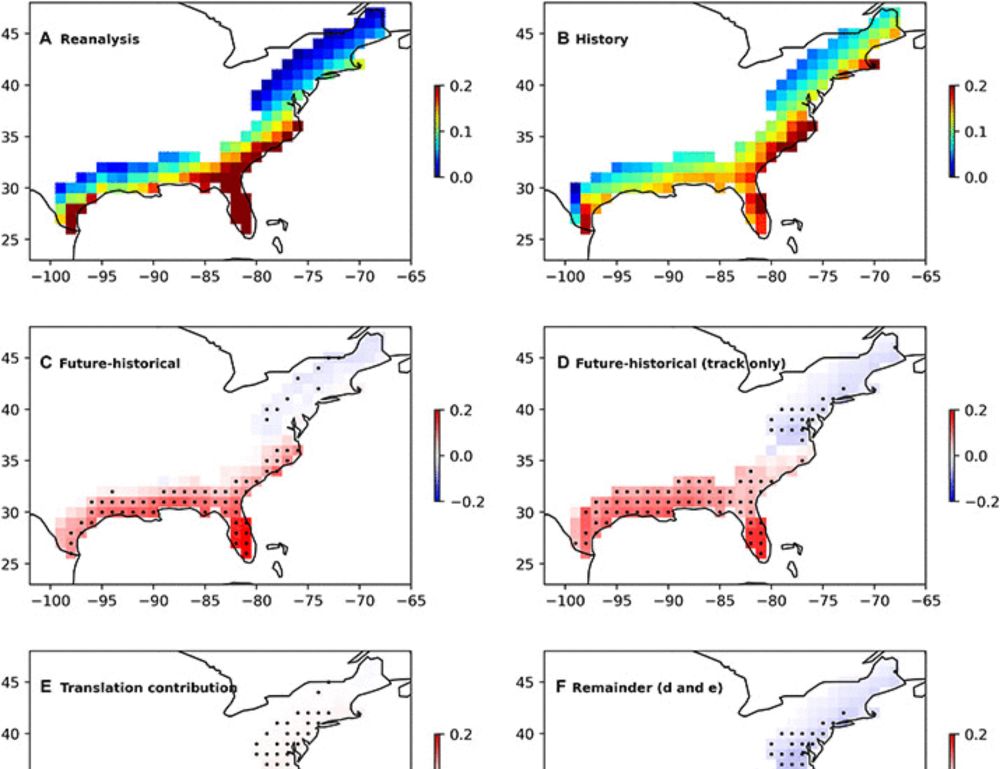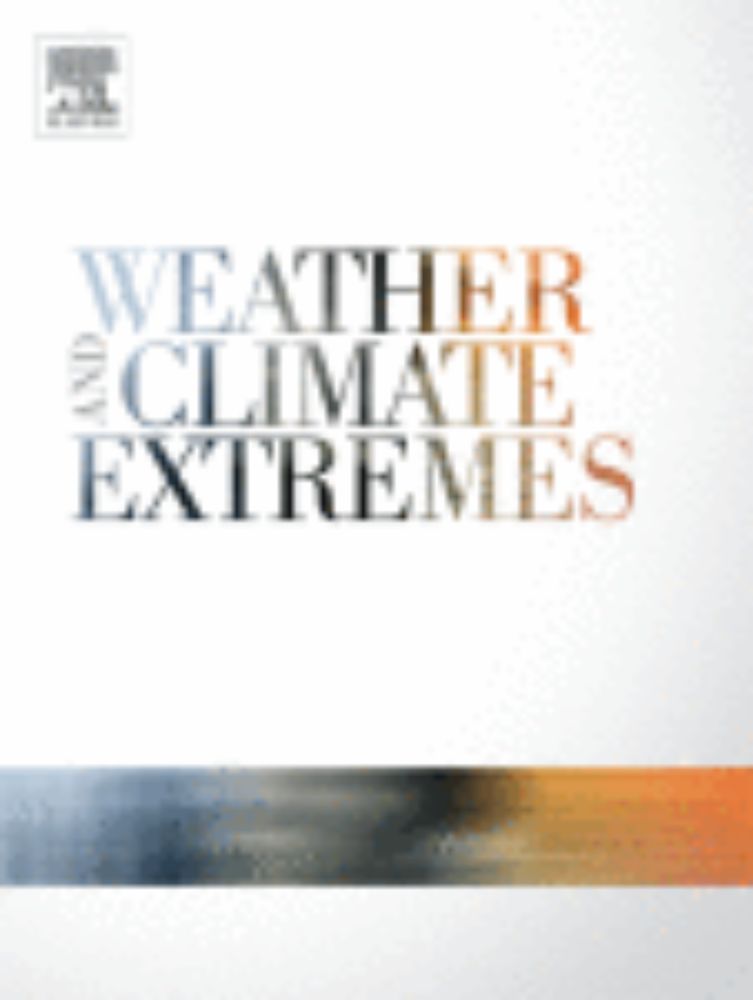"while econometric methods remain valuable for identifying current sensitivities to climate variability, they may be less reliable for long-term projection." But they provide insight, and can guide policy, even if not market investments. Wish I could be there...
November 11, 2025 at 12:22 AM
"while econometric methods remain valuable for identifying current sensitivities to climate variability, they may be less reliable for long-term projection." But they provide insight, and can guide policy, even if not market investments. Wish I could be there...
7. "SRM could exacerbate rather than ameliorate some regional changes in climate..." Seems like an understatement to me. All schemes that I examined produced seasonal drought somewhere, especially in the south. And bulk tropical cyclone metrics are highly uncertain. link.springer.com/article/10.1...

Assessing the performance of solar radiation management geoengineering simulations - Frontiers of Earth Science
Offsetting the global warming caused by anthropogenic increases in atmospheric greenhouse gases by deliberate injection of aerosols into the stratosphere is the most studied of solar radiation managem...
link.springer.com
November 6, 2025 at 7:04 AM
7. "SRM could exacerbate rather than ameliorate some regional changes in climate..." Seems like an understatement to me. All schemes that I examined produced seasonal drought somewhere, especially in the south. And bulk tropical cyclone metrics are highly uncertain. link.springer.com/article/10.1...
We discussed this a bit in our original article. Most would recognize that the SS scale is a poor warning system as it is only wind based and most deaths are due to either fresh or salt water. NHC maps/summaries are infinitely better warnings. See our last paragraph. www.pnas.org/doi/abs/10.1...

The growing inadequacy of an open-ended Saffir–Simpson hurricane wind scale in a warming world | PNAS
Global warming increases available sensible and latent heat energy, increasing the
thermodynamic potential wind intensity of tropical cyclones (TCs...
www.pnas.org
November 3, 2025 at 5:05 AM
We discussed this a bit in our original article. Most would recognize that the SS scale is a poor warning system as it is only wind based and most deaths are due to either fresh or salt water. NHC maps/summaries are infinitely better warnings. See our last paragraph. www.pnas.org/doi/abs/10.1...
2of2 But just a discussion of cat6 raises awareness that storms are now worse than ever because of AGW. Which was the intent of our article. And for that it has served our purpose. www.pnas.org/doi/abs/10.1...

The growing inadequacy of an open-ended Saffir–Simpson hurricane wind scale in a warming world | PNAS
Global warming increases available sensible and latent heat energy, increasing the
thermodynamic potential wind intensity of tropical cyclones (TCs...
www.pnas.org
November 1, 2025 at 6:05 PM
2of2 But just a discussion of cat6 raises awareness that storms are now worse than ever because of AGW. Which was the intent of our article. And for that it has served our purpose. www.pnas.org/doi/abs/10.1...
1of2 My thinking hasn't changed much since Jim Kossin & wrote the PNAS article. The SS scale is very inadequate for communicating imminent danger. But it is not (probably never) going away. A single number can't convey this & we encourage folks to use NHC maps instead or listen to local TV weather.
November 1, 2025 at 6:02 PM
1of2 My thinking hasn't changed much since Jim Kossin & wrote the PNAS article. The SS scale is very inadequate for communicating imminent danger. But it is not (probably never) going away. A single number can't convey this & we encourage folks to use NHC maps instead or listen to local TV weather.
I have been to both many times. Some rooms at EGU can be a lot smaller, so if there is a session you really want to go to, I advise going early to get a seat.
October 23, 2025 at 6:37 PM
I have been to both many times. Some rooms at EGU can be a lot smaller, so if there is a session you really want to go to, I advise going early to get a seat.
It would be interesting to calculate the partitioning of cooling by upwelling compared to energy converted to storm energy.
August 27, 2025 at 1:21 AM
It would be interesting to calculate the partitioning of cooling by upwelling compared to energy converted to storm energy.
Some more literature. Risk is increased near shore which is not good. agupubs.onlinelibrary.wiley.com/doi/10.1029/...

A Global Increase in Nearshore Tropical Cyclone Intensification
Tropical cyclone (TC) intensification rates have increased in near coastal regions over the 42-year period 1979-2020 Increases in relative humidity along with decreases in vertical wind shear are...
agupubs.onlinelibrary.wiley.com
August 18, 2025 at 9:40 PM
Some more literature. Risk is increased near shore which is not good. agupubs.onlinelibrary.wiley.com/doi/10.1029/...
Thanks. And btw, in our cat 6 paper, we do not see substantial risk in the open Atlantic.
August 18, 2025 at 9:36 PM
Thanks. And btw, in our cat 6 paper, we do not see substantial risk in the open Atlantic.
Does eyewall replacement cause the expansion in size? Or is it some other physical mechanism like available energy?
August 17, 2025 at 6:04 PM
Does eyewall replacement cause the expansion in size? Or is it some other physical mechanism like available energy?
Jeff, what is the mechanism causing this expansion in physical size?
August 17, 2025 at 6:00 PM
Jeff, what is the mechanism causing this expansion in physical size?
I am an executive editor for a journal. I would ask now. It may be that they are having trouble finding a suitable AE. Or it may have slipped between the cracks. In any event, the editor should let you know.
August 16, 2025 at 4:30 AM
I am an executive editor for a journal. I would ask now. It may be that they are having trouble finding a suitable AE. Or it may have slipped between the cracks. In any event, the editor should let you know.
And to consider the change in risk of near shore intense storms agupubs.onlinelibrary.wiley.com/doi/10.1029/...
agupubs.onlinelibrary.wiley.com
August 3, 2025 at 5:07 PM
And to consider the change in risk of near shore intense storms agupubs.onlinelibrary.wiley.com/doi/10.1029/...
You may not want to assume that the risk of landfall remains constant at 11% www.science.org/doi/10.1126/...

Increased U.S. coastal hurricane risk under climate change
Future ocean warming in eastern tropical Pacific will enhance US hurricane risk through changes in steering flow and wind shear.
www.science.org
August 3, 2025 at 5:06 PM
You may not want to assume that the risk of landfall remains constant at 11% www.science.org/doi/10.1126/...
I presume these values are from the NOAA look up table. Recent work finds that they underestimate the heat index for very high values. iopscience.iop.org/article/10.1...
July 29, 2025 at 5:13 AM
I presume these values are from the NOAA look up table. Recent work finds that they underestimate the heat index for very high values. iopscience.iop.org/article/10.1...
Probably not above the upper bound. But generally more than 7 standard deviations is "impossible" www.sciencedirect.com/science/arti...

Data-driven upper bounds and event attribution for unprecedented heatwaves
The last decade has seen numerous record-shattering heatwaves in all corners of the globe. In the aftermath of these devastating events, there is inte…
www.sciencedirect.com
July 25, 2025 at 7:29 PM
Probably not above the upper bound. But generally more than 7 standard deviations is "impossible" www.sciencedirect.com/science/arti...
"Extreme weather events, such as hurricanes, droughts and heatwaves, are becoming more frequent and intense..." Present tense; attribution is recognized with this statement.
July 24, 2025 at 9:35 AM
"Extreme weather events, such as hurricanes, droughts and heatwaves, are becoming more frequent and intense..." Present tense; attribution is recognized with this statement.
Congratulations Ben!!!
July 22, 2025 at 3:56 PM
Congratulations Ben!!!
There are very few of us doing rigorous event attribution in the US. Extreme weather events are increasing but attribution scientists numbers are decreasing.😞
July 19, 2025 at 7:50 PM
There are very few of us doing rigorous event attribution in the US. Extreme weather events are increasing but attribution scientists numbers are decreasing.😞

